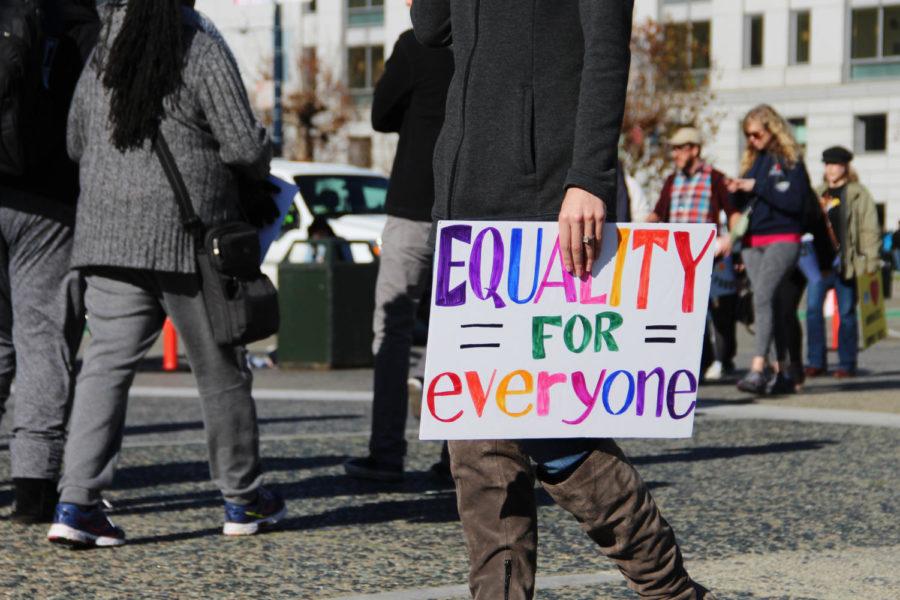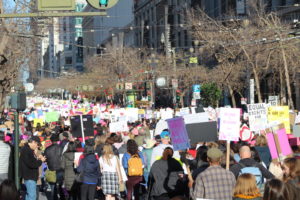The Women’s March is not just for women
Numerous underrepresented groups voice their opinions in the 2018 Bay Area Women’s March
In addition to supporting women’s rights, marchers also hold signs for sexuality and identity equality.
January 21, 2018
The sun beat down on San Francisco City Hall as people gathered to have their voices heard in the 2018 San Francisco Women’s March.
But the fight for women’s rights was not the only topic.
On Jan. 20, tens of thousands of people walked together in a march organized by Women’s March Bay Area, whose goal was to “engage and empower all people to support women’s rights, human rights, civil rights, disability rights, LGBT rights, workers’ rights, immigrant rights, reproductive, social, and environmental justice.”
The event began promptly at noon and the march from San Francisco City Hall to the Embarcadero began at 2 p.m.
Although the Women’s March may have highlighted the fight for women’s rights, many people from underrepresented minority groups also expressed their discontent and desire for change.
Jose Delio, a Salvadoran immigrant, came to the march for two reasons.
“Women [are] under restrictions and having their rights taken away in some way or another. Today, I thought I would come out and support them,” he said.
Many of the additional causes expressed were in response to President Trump and the Republican Party’s threats against the DREAM Act and immigrants from non-European countries.
In support of uniting underrepresented groups, Delio’s sign protested the recent threats to the U.S. DACA program.
“We’re all humans, and I think everyone deserves a right to live anywhere. I don’t think it’s right to send kids back to a country that they don’t even know. This is their home,” Delio said.
Like Delio, Anjana Patel is also an immigrant. She came to the U.S. 37 years ago and joined the supporters of the Women’s March at San Francisco City Hall in response to the recent actions made by the Trump Administration against immigrants.
Patel marched for women’s rights last year in Washington, D.C. and hoped for the unification of other minority groups in San Francisco this year.
“[There is] still a lot of passion, still a lot of anger bringing people out, but also a lot of solidarity, which is really nice,” she said.
Among feminists and immigrants, other groups joined the cause to have their voices heard as well.
Catherine Sobilo, a special-education teacher, joined the march to support women’s rights, but also to shed light on the lack of funding and federal support for special education programs in public schools.
“[Special needs funding] is one of the first things that gets cut in school districts, especially in rural parts of the country. It’s just another group of marginalized people that the world doesn’t really think about. Disability rights are always being impeded,” Sobilo said.
Beyond protesting with posters and chants, artists feeling discontent with the Trump Administration decided to voice their opinions at the San Francisco march with a sculpture.
Before the march began, people gathered around a piece of art depicting Donald Trump sitting on a toilet. The sculpture is part of a project called “Flush: A Protest Project of the 45th Administration.” Contributors to the project paraded the sculpture around the protesters standing in front of City Hall before placing it in the middle of the crowd.
Elaine Badgley-Arnoux, the 91-year-old creator of this project, said, “[This sculpture] is a piece of an 18-part project representing all of the 18 categories in our government that are being flushed down the toilet. For months, I had seen toilets in my building’s garage waiting to be recycled and one day, I had an epiphany: I saw Trump sitting on a toilet. We have extraordinary artists who feel very deeply, as I do, about the actions of the Trump Administration, and we hope to spread awareness of the project.”
Speeches were made about the various groups of underrepresented people until 2 p.m. when the march to the Embarcadero began.
Although the event may be over, the causes that the march showcased are far from being resolved.
“Without representation and without unity, nothing gets done. When people come out for racial unity, class unity, and ability unity, it just says that when you try to take down one of us, you can’t because we’re all together,” Sobilo said.



